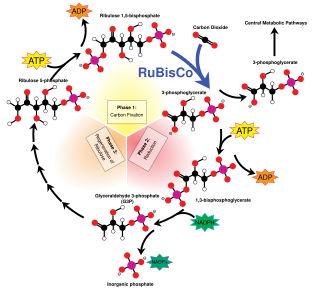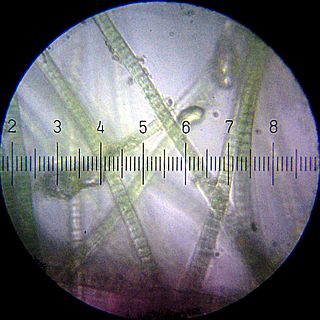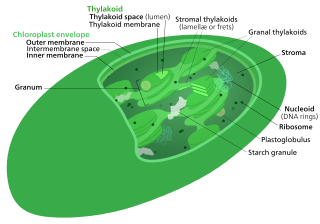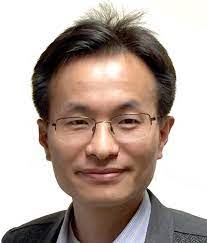Related Research Articles

Photosynthesis is a biological process used by many cellular organisms to convert light energy into chemical energy, which is stored in organic compounds that can later be metabolized through cellular respiration to fuel the organism's activities. The term usually refers to oxygenic photosynthesis, where oxygen is produced as a byproduct and some of the chemical energy produced is stored in carbohydrate molecules such as sugars, starch, glycogen and cellulose, which are synthesized from endergonic reaction of carbon dioxide with water. Most plants, algae and cyanobacteria perform photosynthesis; such organisms are called photoautotrophs. Photosynthesis is largely responsible for producing and maintaining the oxygen content of the Earth's atmosphere, and supplies most of the biological energy necessary for complex life on Earth.
Martin David Kamen was an American chemist who, together with Sam Ruben, co-discovered the synthesis of the isotope carbon-14 on February 27, 1940, at the University of California Radiation Laboratory, Berkeley. He also confirmed that all of the oxygen released in photosynthesis comes from water, not carbon dioxide, in 1941.

Melvin Ellis Calvin was an American biochemist known for discovering the Calvin cycle along with Andrew Benson and James Bassham, for which he was awarded the 1961 Nobel Prize in Chemistry. He spent most of his five-decade career at the University of California, Berkeley.
Samuel Ruben was an American chemist who with Martin Kamen co-discovered the synthesis of the isotope carbon-14 in 1940.

Ribulose 1,5-bisphosphate (RuBP) is an organic substance that is involved in photosynthesis, notably as the principal CO2 acceptor in plants. It is a colourless anion, a double phosphate ester of the ketopentose called ribulose. Salts of RuBP can be isolated, but its crucial biological function happens in solution. RuBP occurs not only in plants but in all domains of life, including Archaea, Bacteria, and Eukarya.

C3 carbon fixation is the most common of three metabolic pathways for carbon fixation in photosynthesis, the other two being C4 and CAM. This process converts carbon dioxide and ribulose bisphosphate (RuBP, a 5-carbon sugar) into two molecules of 3-phosphoglycerate through the following reaction:
The year 1950 in science and technology included some significant events.

Biological carbon fixation or сarbon assimilation is the process by which inorganic carbon is converted to organic compounds by living organisms. The compounds are then used to store energy and as structure for other biomolecules. Carbon is primarily fixed through photosynthesis, but some organisms use a process called chemosynthesis in the absence of sunlight.

The Calvin cycle,light-independent reactions, bio synthetic phase,dark reactions, or photosynthetic carbon reduction (PCR) cycle of photosynthesis is a series of chemical reactions that convert carbon dioxide and hydrogen-carrier compounds into glucose. The Calvin cycle is present in all photosynthetic eukaryotes and also many photosynthetic bacteria. In plants, these reactions occur in the stroma, the fluid-filled region of a chloroplast outside the thylakoid membranes. These reactions take the products of light-dependent reactions and perform further chemical processes on them. The Calvin cycle uses the chemical energy of ATP and reducing power of NADPH from the light dependent reactions to produce sugars for the plant to use. These substrates are used in a series of reduction-oxidation (redox) reactions to produce sugars in a step-wise process; there is no direct reaction that converts several molecules of CO2 to a sugar. There are three phases to the light-independent reactions, collectively called the Calvin cycle: carboxylation, reduction reactions, and ribulose 1,5-bisphosphate (RuBP) regeneration.
Artificial photosynthesis is a chemical process that biomimics the natural process of photosynthesis to convert sunlight, water, and carbon dioxide into carbohydrates and oxygen. The term artificial photosynthesis is commonly used to refer to any scheme for capturing and storing the energy from sunlight in the chemical bonds of a fuel. Photocatalytic water splitting converts water into hydrogen and oxygen and is a major research topic of artificial photosynthesis. Light-driven carbon dioxide reduction is another process studied that replicates natural carbon fixation.

3-Phosphoglyceric acid (3PG, 3-PGA, or PGA) is the conjugate acid of 3-phosphoglycerate or glycerate 3-phosphate (GP or G3P). This glycerate is a biochemically significant metabolic intermediate in both glycolysis and the Calvin-Benson cycle. The anion is often termed as PGA when referring to the Calvin-Benson cycle. In the Calvin-Benson cycle, 3-phosphoglycerate is typically the product of the spontaneous scission of an unstable 6-carbon intermediate formed upon CO2 fixation. Thus, two equivalents of 3-phosphoglycerate are produced for each molecule of CO2 that is fixed. In glycolysis, 3-phosphoglycerate is an intermediate following the dephosphorylation (reduction) of 1,3-bisphosphoglycerate.

Andrew Alm Benson was an American biologist and a professor of biology at the University of California, San Diego, until his retirement in 1989. He is known for his work in understanding the carbon cycle in plants.
Robert George Bergman is an American chemist. He is Professor of the Graduate School and Gerald E. K. Branch Distinguished Professor Emeritus at the University of California, Berkeley.

Joan Mary "Jan" Anderson FAA FRS was a New Zealand scientist who worked in Canberra, Australia, distinguished by her investigation of photosynthesis.
Graham R. Fleming is a professor of chemistry at the University of California, Berkeley and member of the Kavli Energy NanoScience Institute based at UCB.
Daniel Israel Arnon was a Polish-born American plant physiologist and National Medal of Science recipient whose research led to greater insights into the operation of photosynthesis and nutrition in plants.

David Alan Walker was a British scientist and professor of photosynthesis in the Department of Animal and Plant Sciences (APS) at the University of Sheffield. He authored over 200 scientific publications including several books during his lifetime.

Peidong Yang is a Chinese–American chemist, material scientist, and businessman. He is currently a professor at the University of California, Berkeley and a member of the American Academy of Arts and Sciences. He is a Professor of Chemistry and a Professor of Materials Science. His research group studies the synthesis of nanomaterials and their electronic and optical properties. He is also a Department Head at the Joint Center for Artificial Photosynthesis, Senior Faculty Scientist at Lawrence Berkeley National Laboratory, and Deputy Director of the Center of Integrated Nanomechanical Systems (COINS). He is an associate editor of the Journal of the American Chemical Society, an American Chemical Society Journal.
Clifford P. Kubiak is an American inorganic chemist, currently a Distinguished Professor in Chemistry and Biochemistry and the Harold C. Urey Chair in Chemistry at the University of California, San Diego. Over the course of his career, Kubiak has published over 200 scientific articles. He has also received the American Chemical Society Award in Inorganic Chemistry, and is a Fellow of the American Academy of Arts and Sciences and American Chemical Society. In 2020 he was elected to the National Academy of Sciences.

John Rodney (Rod) Quayle FRS (1926–2006) was a microbial biochemist, West Riding Professor of Microbiology and Head of Department at University of Sheffield (1965–1983) and then Vice-Chancellor of Bath University (1983–1992). He adopted techniques for dissecting enzymic reactions using radioactive carbon-14. He focused on microbes that used compounds containing one atom of carbon as their sources of energy and biomass.
References
- ↑ Pamela M. Kalte (2003). American men & women of science. Thomson/Gale. p. 377. ISBN 978-0-7876-6524-1.
- ↑ Bassham, James A. (2003). "Mapping the carbon reduction cycle: A personal retrospective". Photosynthesis Research. 76 (1–3): 35–52. doi:10.1023/A:1024929725022. PMID 16228564. S2CID 52854452.
- ↑ James Bassham's obituary